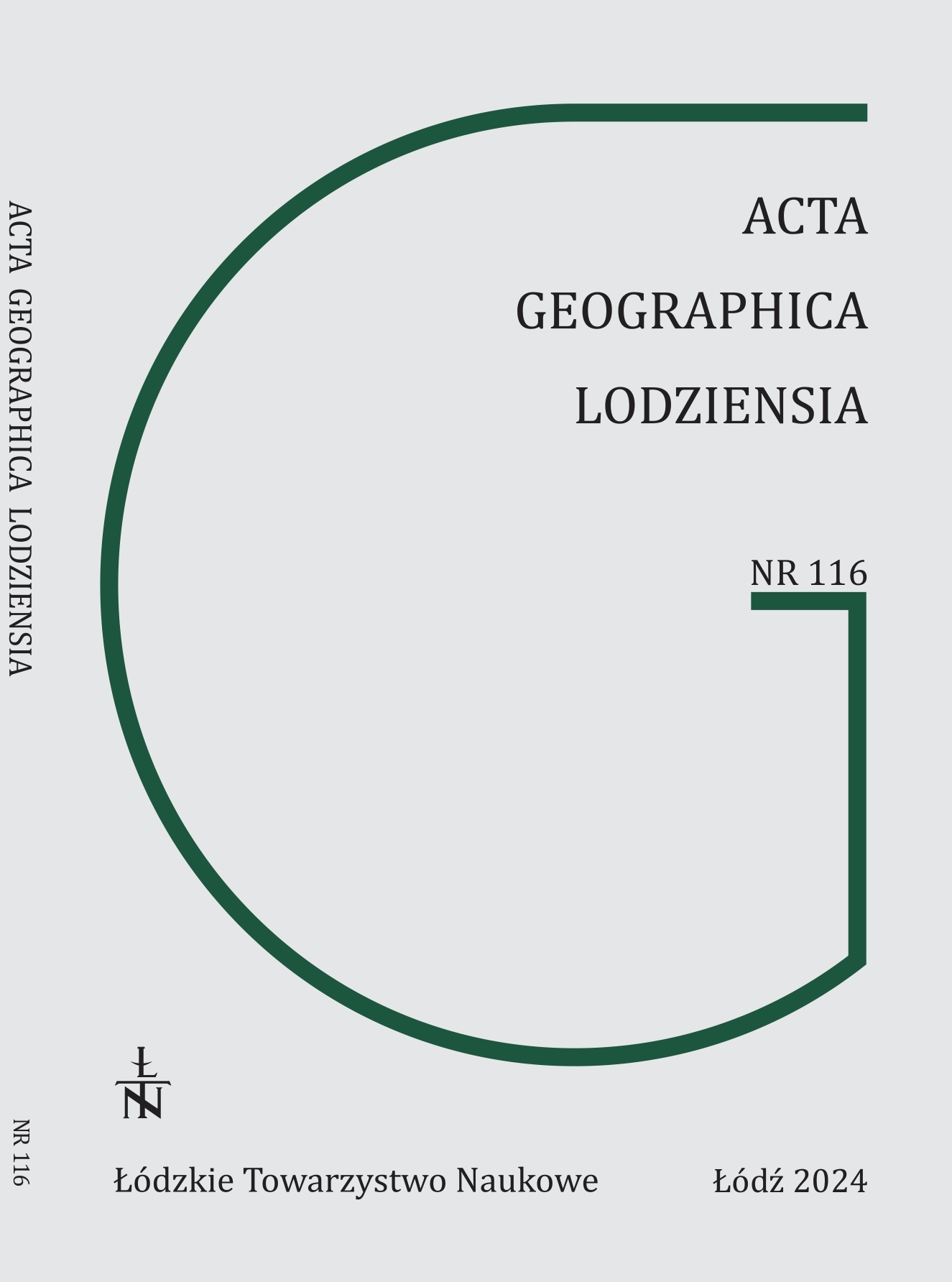Geometry and development of the ice-cored ridges in the Kutno Moraine: evidence from lithofacies and deformation structures of supraglacial deposits in Daszyna site
DOI:
https://doi.org/10.26485/AGL/2024/116/11Keywords:
supraglacial landforms, collapse structures, strain fields, youngest Saalian ice-sheetAbstract
The ice-cored ridges are important for palaeogeographical studies of retreating margins of glaciers. Earlier reconstructions of ice-cored ridges in marginal zones of the Pleistocene ice-sheets have been made based on sedimentological studies. Applying such approach, research were able only to show in which degree depressions between ice-cored ridges influenced spatial variations in depositional processes. There is possible to determine more precise characteristics of ice-cored ridges geometry based on detailed analysis of collapse structures. The shape, elongation and orientation of ice-cored ridges can be derived from geometry and kinematics of folds and faults as major elements of the collapse structures. Integration sedimentological studies of supraglacial deposits with analysis of collapse structures also allows to determine the evolution of ice-cored ridges up to final deicing. This approach is the subject of case study performed in Daszyna site located in the Kutno Moraine.
References
Acocella V. 2007. Understanding caldera structure and development: an overview of analogue models compared to natural calderas. Earth-Science Reviews 85: 125-160.
Boulton G.S. 1972. Modern arctic glaciers as depositional models for former ice sheets. Journal of the Geological Society of London 128: 361--393.
Branney M.J. 1995. Downsag and extension at calderas: new perspectives on collapse geometries from ice-melt, mining, and volcanic subsidence. Bulletin of Volcanology 57: 303-318.
Cole J.W., Milner D.M., Spinks K.D. 2005. Calderas and caldera structures: a review. Earth-Science Reviews 69: 1-26.
Domosławska-Baraniecka M.D. 1961. Przebieg sedymentacji i kształtowania kutnowskich moren czołowych w okolicy Sławęcina. Prace o plejstocenie Polski środkowej. INQUA Congress, Warszawa: 59-77.
Drążczyk M.A. 2020. Structure of end moraines and dynamics of the recession phase of the Warta Stadial ice sheet, Kłodawa Upland, Central Poland. Open Geoscience 12: 753-763.
Evans D.J.A. 2009. Controlled moraines: origins, characteristics and palaeoglaciological implications. Quaternary Science Reviews 28: 183--208.
Ge H., Jackson M.P.A. 1998. Physical modeling of structures formed by salt withdrawal: implications for deformation caused by salt dissolution. AAPG Bulletin 82: 228-250.
Gruszka B. 2001. Climatic versus tectonic factors in the formation of the glaciolacustrine succession (Bełchatów outcrop, central Poland). Global and Planetary Change 28: 53-71.
Gruszka B. 2007. The Pleistocene glaciolacustrine sediments in the Bełchatów mine (central Poland): endogenic and exogenic controls. Sedimentary Geology 193: 149-166.
Gruszka B., Terpiłowski S. 2015. Sedimentary record of the younger Saalian ice margin stagnation in eastern Poland: development of a regular pattern of glaciolacustrine kames. Geografiska Annaler, Series A, Physical Geography 97: 279-298.
Gruszka B., Zieliński T. 2021. Lacustrine deltas and subaqueous fans: almost the same, but different – a review. Geologos 27(1): 43-55.
Healy D., Blenkinsop T.G., Timms N.E., Mere- dith P.G., Mitchell T.M., Cooke M.L. 2015. Polymodal faulting: time for a new angle on shear failure. Journal of Structural Geology 80: 57-71.
Holohan E.P., Schöpfer M.P.J., Walsh, J.J. 2015. Stress evolution during caldera collapse. Earth and Planetary Science Letters 421: 139--151.
Huddart D., Bennett M.R. 1997. The Carstairs Kames (Lanarkshire, Scotland): morphology, sedimentology and formation. Journal of Quaternary Science 12: 467-484.
Jewtuchowicz S. 1967. Geneza pradoliny warszawsko-berlińskiej między Nerem i Moszczenicą. Prace Geograficzne 62.
Johnson M.D., Clayton L. 2003. Supraglacial landsystems in lowland terrain. W: D.J.A. Evans (red.) Glacial Landsystems. Arnold, London: 228-258.
Kasprzak L. 2003. Model Sedymentacji Lądolodu Vistuliańskiego na Nizinie Wielkopolskiej. Wyd. Naukowe Uniwersytetu Adama Mickiewicza, Poznań.
Kłapyta P. 2008. Reliktowe wały lodowo-morenowe w zachodniej części Cyrku Pyszniańskiego, Tatry Zachodnie. Prace Geograficzne 120: 65-77.
Kozarski S., Szupryczyński J. 1973. Glacial forms and deposits in the Síðujökull deglaciation area. Geographia Polonica 26: 255-311.
Krantz R.W. 1988. Multiple fault sets and three-dimensional strain: theory and application. Journal of Structural Geology 10: 225-237.
Lencewicz S. 1927. Dyluwium i morfologia środkowego Powiśla. Prace Państwowego Instytutu Geologicznego 2.
McDonald B.C., Shilts W.W. 1975. Interpretation of faults in glaciofluvial sediments. W: A.V. Jopling, B.C. McDonald (red.) Glacio-fluvial and Glaciolacustrine Sedimentation. SEPM, Special Publication 23, Tulusa, Oklahoma: 639-646.
Molewski P. 2014. Paleogeograficzne uwarunkowania odpływu wód z zastoiska warszawskiego doliną Bachorzy i pradoliną warszawsko-berlińską w czasie stadiału głównego zlodowacenia wisły. Landform Analysis 25: 205--114.
Muskett R., Tangborn W., Sauber J.R., Rabus B. 2008. Surging, accelerating surface lowering and volume reduction of the Malaspina Glacier system, Alaska, USA, and Yukon, Canada, from 1972 to 2006. Journal of Glaciology 54: 788-800.
Paterson M.S., Weiss L.E. 1961. Symmetry concepts in the structural analysis of deformed rocks. Geological Society of America Bulletin 72: 841-882.
Rains R.B., Shaw J. 1981. Some mechanisms of controlled moraine development. Antarctica. Journal of Glaciology 27: 113-128.
Szupryczyński J. 1963. Rzeźba strefy marginalnej i typy deglacjacji lodowców południowego Spitsbergenu. Prace Geograficzne IG PAN 39.
Wasiluk R., Rychel J. 2021. Objaśnienia do Szczegółowej mapy geologicznej Polski w skali 1: 50 000, arkusz Krośniewice (516). Państwowy Instytut Geologiczny, Warszawa.
Włodarski W., Orłowska A. 2019. Topography and melting dynamics of ice-cored ridges: evidence from the geometry, kinematics and sedimentary evolution of collapse structures within kame deposits, eastern Poland. Boreas 48: 891-912.
Zieliński T. 2014. Sedymentologia. Wyd. Bogucki, Poznań.
Zieliński T., Van Loon A.J. 1996. Characteristics and genesis of moraine-derived flowtill varieties. Sedimentary Geology 101: 119-143.
Downloads
Published
How to Cite
Issue
Section
License
Copyright (c) 2024 Łódzkie Towarzystwo Naukowe

This work is licensed under a Creative Commons Attribution-NonCommercial-NoDerivatives 4.0 International License.



